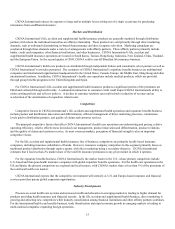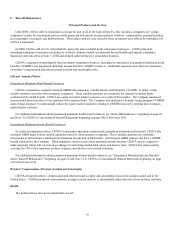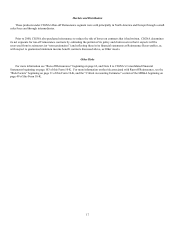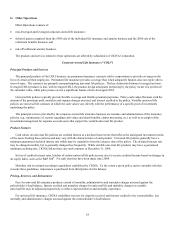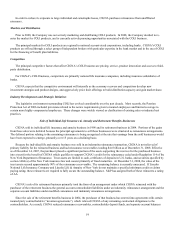Cigna 2008 Annual Report Download - page 29
Download and view the complete annual report
Please find page 29 of the 2008 Cigna annual report below. You can navigate through the pages in the report by either clicking on the pages listed below, or by using the keyword search tool below to find specific information within the annual report.9
• individuals;
• government, which includes employees in federal, state and local governments, primary and secondary schools, and colleges and
universities;
• Taft-Hartley plans, which includes members covered by union trust funds;
• seniors, which focuses on the health care needs of individuals 50 years and older;
• voluntary, which focuses on employers with working uninsured employees; and
• emerging markets, which includes non-CIGNA HealthCare payors to which leased network and other services are offered.
To date, the national and regional account markets have comprised a significant amount of CIGNA HealthCare’s business. With
the acquisition of Great-West Healthcare, the healthcare division of Great-West, the “Select,” small business, and emerging markets
now constitute a larger share of CIGNA HealthCare’s business.
CIGNA HealthCare employs group sales representatives to distribute its products and services through insurance brokers and
insurance consultants or directly to employers. CIGNA HealthCare also employs representatives to sell utilization review services,
managed behavioral health care and employee assistance services directly to insurance companies, HMOs, third party administrators
and employer groups. As of December 31, 2008, the field sales force for the products and services of this segment consisted of
approximately 970 sales representatives in approximately 120 field locations.
Competition
CIGNA HealthCare’s business is subject to intense competition, and industry consolidation has created an even more competitive
business environment. While no one competitor dominates the health care market, CIGNA HealthCare expects a continuing trend of
consolidation in the industry given the current economic environment.
In certain geographic locations, some health care companies may have significant market share positions. A large number of
health care companies and other entities compete in offering similar products. Competition in the health care market exists both for
employers and other groups sponsoring plans and for the employees in those instances where the employer offers its employees the
choice of products of more than one health care company. Most group policies are subject to annual review by the policyholder, who
may seek competitive quotations prior to renewal.
The principal competitive factors are: quality and cost-effectiveness of service and provider networks; effectiveness of medical
care management; product responsiveness to the needs of customers and their employees; cost-containment services; technology;
price; and effectiveness of marketing and sales. Financial strength of the insurer, as indicated by ratings issued by nationally
recognized rating agencies, is also a competitive factor. For more information concerning insurance ratings, see “Ratings” in Section J
beginning on page 28. CIGNA HealthCare believes that its national scope, integrated approach to consumer engagement, breadth of
product and funding offerings, clinical care and medical management capabilities and funding options are strategic competitive
advantages. These advantages allow CIGNA HealthCare to respond to the diverse needs of its customer base in each market in which
it operates. CIGNA HealthCare also believes that its focus on helping to improve the health, well-being and security of its members
will allow it to distinguish itself from its competitors.
The principal competitors are:
• other large insurance companies that provide group health and life insurance products;
• Blue Cross and Blue Shield organizations;
• stand-alone HMOs and PPOs;
• third party administrators;
• HMOs affiliated with major insurance companies and hospitals; and


















